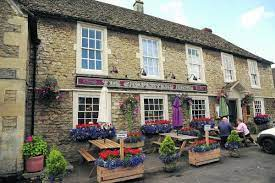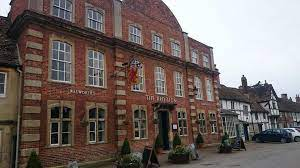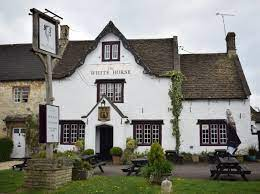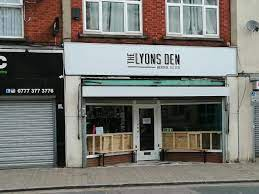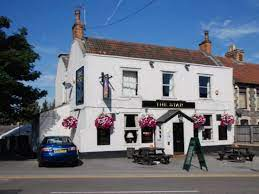The second day of my excursion to the South-West was decidedly more unsettled weather-wise than it had been the previous day which influenced our plans as to what to do next. Due to the forecast of showers and the fact that Matt was playing his gig that night so would have to limit his alcohol intake, Matt proposed that we take a trip out in the car to some villages in the neighbouring county of Wiltshire where he promised cracking pubs, good beer and some excellent historical locations. I'm always up for investigating new places, particularly when there are pubs involved so I was instantly taken with this plan. Without further ado, we set off through the country roads and after approximately half an hour our day's adventures began in earnest. First up on our village-hopping excursion was Lacock.
Lacock is a village and civil parish in Wiltshire, about 3 miles (5 km) south of the town of Chippenham. The village is owned almost in its entirety by the National Trust and attracts many visitors by virtue of its unspoiled appearance.
The parish includes Bowden Hill, a small village 1 mile (1.6 km) to the east of Lacock, and the hamlets of Bewley Common, Notton and Reybridge. The Chippenham–Melksham section of the A350 primary route crosses the parish from north to south, as does the River Avon.
A scarecrow festival is held annually in Lacock and is popular with visitors from the local area. All funds raised are donated to Lacock Primary School.
Lacock is mentioned in the Domesday Book, with a population of 160–190; with two mills and a vineyard. Lacock Abbey was founded on the manorial lands by Ela, Countess of Salisbury and established in 1232; and the village – with the manor – formed its endowment to "God and St Mary". Lacock was granted a market and developed a thriving woollen industry during the Middle Ages. Reybridge, and a packhorse ford, remained the only crossing points of the River Avon until the 18th century.
At the dissolution, the Abbey and estate, including the village, were sold to William Sharington, later passing into the Talbot family by marriage. Lacock estate was home to photography pioneer Henry Fox Talbot from 1800 to 1877.
In 1916 Henry Fox Talbot's son Charles bequeathed the Lacock estate to his niece, Matilda Gilchrist-Clark, who took the name of Talbot. The estate – comprising 284 acres (1.15 km2), the Abbey and the village – was given to the National Trust in 1944 by Matilda Talbot. Lacock has three public houses and a number of shops in its High Street including a grocery store, a bakery, gift shops and a National Trust shop.
Most of the surviving houses in the village are 18th century or earlier in construction. Lacock Abbey, the 14th-century St Cyriac's Church and a 14th-century tithe barn are Grade I listed. Elsewhere in the parish, the country houses at Bewley Court (14th century, restored 1920) and Bowden Park (1796) are also Grade I listed.
There are four Grade II* listed structures: The Sign of the Angel (late 15th-century house, now an inn); a village cross (late medieval, re-erected outside the school in the late 19th century); a pair of bridges carrying the Bowden Hill road over the Avon (late medieval, 17th and 19th century); and a 16th-century conduit house, part of the abbey's water supply, opposite Bowden Hill church. Next to the tithe barn is a small lock-up from the late 18th century.
Lackham House, in the north of the parish overlooking the Avon, was built in 1791–6 for James Montagu, naval officer. It is a three-storey country house in Palladian style.
The village has been used as a film and television location, notably for the 1995 BBC production of Pride and Prejudice and the 2007 BBC production of Cranford. It also made brief appearances in the Harry Potter films Harry Potter and the Philosopher's Stone and Harry Potter and the Half-Blood Prince, and in the spin-off film Fantastic Beasts: The Crimes of Grindelwald. In the spring of 2012, it was a filming location for the fantasy adventure film Mariah Mundi and the Midas Box. In 2015 it was used for a series of Downton Abbey episodes, and in late 2018 for scenes from the Downton Abbey film to be released in September 2019.
We arrived in this hugely historical village shortly after 11am, taking advantage of Matt's National Trust membership to park for free in the village car park. We began by making a quick lap of the village on foot, which didn't take long at all, before settling onto our first location. Our first stop would be The Carpenters Arms.
Situated on Church Street, opposite the village bakery, The Carpenters Arms is much larger than it first appears. The interior is homely, with lots of original features including beams, exposed brickwork and doors that are no longer used. Bric-a-brac and photos adorn the walls and fireplace. The entrance leads through to the left where the bar is located in one corner. Other space is taken up by a counter selling cakes, ice creams and local memorabilia. To the right is a more restaurant style space with a number of tables set out for dining. A smaller room is to the rear with more seating and artefacts. The bar itself is small and relatively well stocked with a single handpump dispensing a changing ale. At the time of our visit, this was Prescott Hill Climb (3.8%). This is a straw-coloured session beer with a refreshing, fruity finish. Having procured a pint and a half of this, we took a seat at a small table off to one side where we shaped our plans for the afternoon and worked out that we would easily be able to fit in everything we had planned before we had to get back to the flat to pick up Matt's drum kit. There was no time to lose and it was soon to head to our next location.
A couple of minutes walk from the first pub is one of the oldest buildings in the village and that's where we would now end up. Next stop, The George Inn.
Good Beer Guide listed, this stone and timber pub dates from 1361 and was formerly known as the George & Dragon. Oak beams and a large inglenook fireplace are still in situ as is an original dog driven roasting spit. The entrance takes you into a central area with the bar slightly over to one side and lots of wooden seating throughout, some of it set up for Sunday afternoon diners. The George is a Wadworth property so their beers are prevalent. 6 handpulls take up much of the bar space offering Wadworth IPA, 6X, Swordfish, Horizon, Horizon Chilled (which is a thing apparently) and a guest beer in the shape of Sharp's Atlantic. I rather enjoy well kept Wadworth beers so decided on the Horizon (4%). We decided to take advantage of a break in the rain to enjoy the beer garden, situated to the rear. It's a very atmospheric garden with picnic style tables, an old cart wheel on one wall, the remains of an old pillory in the centre and even some house martins apparently roosting in the eves. The beer is very good as well! Horizon is a pale gold-coloured beer with zesty citrus and hop aromas and a crisp, almost tangy finish. It's no surprise that this place has been lauded locally for its beer.
Wadworth has 2 pubs in this small village and it was now time to make our way to the second. A short walk away from The George is its sister pub, The Red Lion.
This red brick former coaching inn was originally built in the Georgian period in 1722. The pub is large and caters for both drinkers and diners although much more in favour of the latter. The narrow entrance opens into the wide bar area with dining tables throughout and a couple of higher tables nearer the door. The bar is against the rear wall approximately opposite the doorway and features 5 handpulls all with beers from Wadworth in this case the same as those at the George, namely: IPA, 6X, Swordfish, Horizon and Horizon Chilled. I went down a slightly different route this time and opted for the Swordfish (5%). This is a full-bodied deep copper ale flavoured with Pussers Rum. It's delicious and certainly removed any lingering tiredness from the day before. We sat outside again here, on a round picnic table with a view through shrubbery to the high street beyond. For a Sunday, the pubs had been nicely quiet and welcoming despite beginning to fill up as the afternoon drew on. The Red Lion is another cracking place in a very nice village and it's nice to see so many old pub with original features intact. One original feature that also appears to have remained is at least one resident ghost, in the form of a white lady seen occasionally by staff in the upper levels of the building, Not much more is known about her but she is apparently harmless enough.
A bit more walking was required to reach the next pub in Lacock, as it is situated just outside the village centre. This meant walking approximately half a mile down a country lane and over a small bridge with no footpath that carries the road over the Avon and through very attractive countryside. It also meant we got more of a view of the village centrepiece, Lacock Abbey itself. It's immediately obvious why it's been used for filming such iconic scenes. It also has something of a dark side about it. The 16th century mansion on the site is the reputed haunt of a deformed dwarf like entity dressed all in black. The identity of this figure is unknown but the description matches that of a skeleton that was found buried in a wall of one particular room. Sightings continue periodically and people are known to flee in abject terror. A more serene entity is the white lady with a mournful expression seen strolling beside the lake located in the grounds. Local belief suggests she may be Rosamund Clifford, mistress of Henry II. A similar looking figure was once seen by a photographer on the west steps of the Abbey but vanished as he approached her. Speculation suggest that these figures may be one and the same. It's certainly an atmospheric and powerful sight as you cling to the stone walls that mark the boundary of the Abbey grounds and make your way past.
More earthly delights awaited us a short walk up the hill out of the village. Our trip to Lacock would conclude at The Bell Inn.
This Good Beer Guide listed pub sits on the line of the Wiltshire & Berkshire canal and has won the local Pub of the Year award 9 times. It's certainly a welcoming little place and we enter to find a small bar with seating immediately adjacent and a larger room behind with lots more space for both food and drink. The pub is moderately busy with locals and regulars enjoying their Sunday afternoon and we were eager to be amongst them, The bar boasts 6 handpulls, 5 of which were in use on our visit. One of these is the house beer, Beau Bell, brewed by Great Western Brewery to the landlord and landlady's recipe to commemorate the birth of their first child. The other 4 pumps offer us a choice of Quantock Mild, Plain Ales Inn the Sun, Three Castles Barbury Castle and Weston's Reserve Cider. I decided on Inn the Sun (4.6%) from Plain Ales in Sutton Veny. This was an excellent choice! It's a blonde beer with sweet aromatic malts and hints of citrus and tropical fruit. If only the sun could come out for the day, this beer would be the perfect accompaniment. We managed to find a small table adjacent to the bar and near the entrance to enjoy our beers and soak up our surroundings. This is an awesome pub and a clear gem at the heart of the local community. I'm very pleased that we made the effort to come out here to find it.
Our trip to Lacock was concluded here but the day itself was just beginning. We made our back down the hill (much quicker than up), past the abbey and back to the car. A few short minutes away was our next destination, the town of Corsham.
Corsham is a historic market town. It is at the south-western edge of the Cotswolds, just off the A4 national route, which was formerly the main turnpike road from London to Bristol, 28 miles (45 km) southwest of Swindon, 20 miles (32 km) southeast of Bristol, 8 miles (13 km) northeast of Bath and 4 miles (6 km) southwest of Chippenham. Corsham is close to the county borders with Bath and North East Somerset and South Gloucestershire.
Corsham was historically a centre for agriculture and later, the wool industry, and remains a focus for quarrying Bath Stone. It contains several notable historic buildings, such as the stately home of Corsham Court. During the Second World War and the Cold War, it became a major administrative and manufacturing centre for the Ministry of Defence, with numerous establishments both above ground and in the old quarry tunnels. The early 21st century saw growth in Corsham's role in the film industry.
The parish includes the villages of Gastard and Neston, which is at the gates of the Neston Park estate.
Corsham appears to derive its name from Cosa's hām, "ham" being Old English for homestead, or village. The town is referred in the Domesday book as Cosseham; the letter 'R' appears to have entered the name later under Norman influence (possibly caused by the recording of local pronunciation), when the town is reported to have been in the possession of the Earl of Cornwall. Corsham is recorded as Coseham in 1001, as Cosseha in 1086, and as Cosham as late as 1611 (on John Speed's map of Wiltshire). The Corsham area belonged to the King in Saxon times, the area at the time also had a large forest which was cleared to make way for further expansion.
There is evidence that the town had been known as "Corsham Regis" due to its reputed association with Anglo-Saxon Ethelred of Wessex, and this name remains as that of a primary school.
One of the towns that prospered greatly from Wiltshire's wool trade in medieval times, it maintained its prosperity after the decline of that trade through the quarrying of Bath stone, with underground mining works extending to the south and west of Corsham.
Numbers 94 to 112 of the High Street are Grade II* listed buildings known as the "Flemish Weavers Houses", however there is little cogent evidence to support this name and it appears more likely to derive from a handful of Dutch workers who arrived in the 17th century.
Corsham also contains the historic Georgian house, The Grove, opposite the high street, a typical example of classic Georgian architecture.
Corsham's small town centre includes the Martingate Centre, a late 20th-century retail development, which also houses offices and a small teaching facility for Wiltshire College, a further education institution.
The stately home of Corsham Court can also be found in the town centre. Standing on a former Saxon Royal Manor, it is based on an Elizabethan manor home from 1582. Since 1745, it has been part of the Methuen estate. The house has an extensive collection of Old Masters, rooms furnished by Robert Adam and Thomas Chippendale, and parks landscaped by Capability Brown and Humphry Repton. The house is open to the public all year round excluding December and is famed locally for its peacocks, which freely wander about the streets. The owner of Corsham Court in the mid-seventeenth century was the commander of the Parliamentarian New Model Army in Wiltshire; his wife built what came to be known as the Hungerford Almshouses in the centre of town.
Another place with lots of history, I was eager to see what Corsham's drinking establishments had in store for us. We easily found a parking space at a nearby pay & display car park where Sunday fees had recently been suspended and so we parked for free. Our first stop in Corsham was a short walk away. We began at the Methuen Arms.
Situated at the end of the historic high street, the Methuen Arms is a former coaching inn and named after a prominent local family. As well as being a pub, it is also a restaurant and a conference space with an upmarket but down to earth feel. The interior is space and the exterior is considerable with an impressive garden that includes a herb patch used by the kitchen. Butcombe Brewery took over the pub in 2016 and carried out an extensive renovation that was completed in 2017. Inside, a room to the right of the entrance contains the bar and a small room with tables for drinkers. Another room further up accesses another room with lots of standing space that is served by the same bar. Another larger room further up is used primarily as a restaurant space with an extensive kitchen taking up the opposite side of the corridor. The pub is moderately busy when we arrive but empties out as a large group in the opposite room leave. Whilst Matt answers a call of nature, I familiarise myself with the bar taps. 6 handpulls occupy the bar with a bank of 4 in the room I'm in and 2 facing into the room opposite. Unsurprisingly, Butcombe beers take centre stage with Adam Henson's Rare Breed and Butcombe Original doubled up and Butcombe Gold available on a single hand pump. There is also a guest beer in the shape of Liberation IPA from Liberation Brewery in Jersey. It is to this latter that I am drawn and, with Matt having returned, we partake in it and sit a small table not far from the bar. The beer is very good. At 4.8%, it's a traditional IPA with the flavour of citrus hop and a crisp, balanced finish. The Methuen Arms is well worth a visit. It's clear that money has been spent on it but this has in no way diminished the character and style of the place. This was a good place to begin our exploration of Corsham.
Our next location lay just up the street and neither of us were prepared for what we would find at the Flemish Weaver.
Formerly known as the Pack Horse, this 17th Century ale house takes its name from the Flemish Weavers that fled religious persecution and in turn helped to enhance the town's woollen industry. The cottages in which they lived are still occupied by local tenants. This is the oldest part of the town centre and is a stone's throw from Corsham Court which is still occupied by the Methuen family. The pub itself was extensively refurbished in 2017 and the inside is wonderful. There are nooks and crannies all over the place, filled with all manner of items from old brewery signs and posters to comedy signs behind the bar. The lighting is subdued and the atmosphere is cosy and welcoming. This place is an absolute belter and would turn out to be one of the pubs of the day. It's no surprise at all that the pub is Good Beer Guide listed. We entered into its tiny warren of rooms and located the bar off to one side. Seating throughout varies from proper tables to low benches and we noticed that there was just such a bench immediately opposite the bar that was unoccupied and which we would shortly be making our own. One the bar are 5 handpulls with a variety of options on the day in the shape of Marston's 61 Deep, Wadworth Flemish Ale, Three Daggers Dagger's Edge, Ramsbury Milk Stout and Hog's Back T.E.A. I was immediately drawn to the Three Daggers but this turned out to have just run out so I swapped to the T.E.A, a rarity in these parts from Hog's Back in Surrey. This was once again a very good decision. T.E.A. (4.2%) is a tawny coloured best bitter with toffee and malt on the nose, a well-rounded flavour and a fruity sweetness. We sat on the aforementioned bench and absorbed just how impressive this place is. The charm and age of the building have been left unaltered and original features abound including exposed beams and higgledy-piggledy hallways. It's almost like stepping back in time and its certainly a testament to the management and the owners that it's been allowed to keep its almost otherworldliness. Otherworldliness seems to be a recurring theme here. Around 2010, the then landlady was forced to call in help to deal with an apparent spiritual presence that had sent an ironing board flying and apparently tripped her down the stairs resulting in bad bruising. A séance conducted at the pub to try and get to the bottom of the disturbances resulted in a butter plate flying off the table and smashing on the floor. Staff at the pub also reported the outline of a male apparition in the pub, often seen standing by a window. Further seances appear to have resolved the issue as the activity soon died down. Whether or not anything unusual has occurred since is not clear but given the building's age and history one can't help but wonder.
It was a real shame that we had to leave the Flemish Weaver but time was getting on. Luckily for us, our next location was just over the road and almost opposite. We made our way to the Royal Oak.
More or less slap bang in the middle of the town, the Royal Oak is a Wadworth property of a decent size and with a large beer garden and upstairs function room. There are also rooms to rent on the upper floors. The bar is roughly central and serves two distinct areas to either side. 3 handpulls perch on the bar with 2 of these in use upon our arrival. The choices were once again Wadworth, this time between 6X and IPA. The 6X seemed like a good shout at this stage and was very well kept which you would hope in one of its own pubs. We spent a good few minutes here, thinking back over what we'd done so far and how good the pubs and beer had been. Corsham is a great town that I wouldn't be averse to visiting again in future. It's certainly brimming lots of history and strange stories. Just such a strange story is associated with the Royal Oak itself. In 2007, a paranormal investigation group offered to spend the night at the pub following sightings of a black figure approaching staff and appearing throughout the building. Sightings continue to this day with no clear explanation as to who or what the figure might be. I suspect the building may once have been a coaching inn so perhaps a former guest is outstaying their welcome. Regardless, I can heartily recommend the pubs of Corsham to anyone who may be in the area. You won't be disappointed.
It was back to the car again and we had time for one more stop before we would have to make our way back to Bristol. Once again, it was merely a few minutes before we had arrived, this time in the village of Biddestone.
Biddestone is a village and civil parish about 3 miles (5 km) west of Chippenham and 2 miles (3.2 km) north of Corsham. The parish includes the smaller settlement of Slaughterford.
The Bybrook River forms the western boundary of the parish, while the northern boundary follows approximately the Bristol to Chippenham road, now the A420.
The parish is just inside the eastern boundary of the Cotswolds Area of Outstanding Natural Beauty. Sites of Special Scientific Interest include Honeybrook Farm and Colerne Park and Monk's Wood, both near Slaughterford.
Biddestone was a filming location for the TV film Agatha Raisin and the Quiche of Death (2014), and for The Christmas Candle (2013).
The village itself contains 2 pubs but time permitted we could only visit one and that would be the White Horse.
Originally a coaching inn and situated close to the village pond, the White Horse is a quiet, friendly place with a convivial atmosphere. Inside, there are 3 rather small carpeted rooms but there is also a large garden to the rear providing plenty of space for children or, more preferably, dogs. The bar is roughly in the centre of the 3 rooms and features 4 handpulls which offered us a choice between Sharp's Doom Bar, St. Austell Tribute, Timothy Taylor Landlord and Courage Best. I took a moment to decide but then eventually went for the Landlord. This proved to be a well founded decision as it was in perfect condition. We pulled up a chair at a nearby table and toasted our success in completing our full itinerary for the day.
And what a day it had been! I admit I haven't been to Wiltshire that many times but every time I have, it's been great. The villages and towns and the pubs within are some of the best in the country, the people are friendly and welcoming and the beers are great. What struck me the most though is the sense of community. Every pub we visited had the air of a place that gets everyone together through thick and thin and that does its utmost to keep plugging away and looking after each other in what have recently become trying times both economically and socially. The community spirit is alive and well in Wiltshire and long may it reign! But not just reign, may it grow and continue to benefit everyone, near and far, all across our fair isle. It had been a brilliant afternoon and a brilliant weekend which would get even better at Matt's gig later that night. The band smashed it! They're called Typan by the way and you should definitely, absolutely check them out! On the whole, this impromptu journey had been fantastic. I found some great new places in some lovely little parts of the country that really don't get the praise they should, I uncovered some fascinating history, some great stories and, most importantly some wonderful beers at even more wonderful pubs. That's what counts after all!







